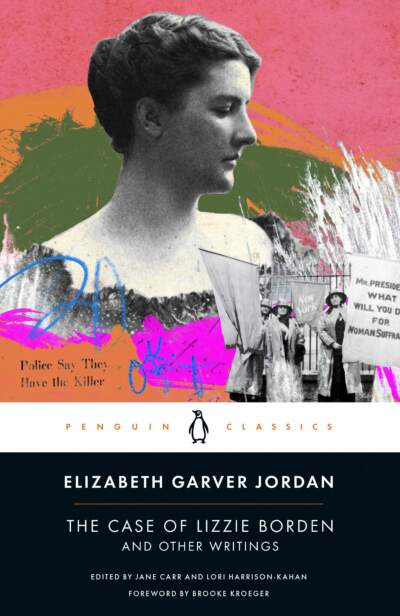Advertisement
A new collection aims to pull a pioneering female journalist out of obscurity
“In whatever way you look at the case of Lizzie Borden no halfway terms will describe it,” wrote Elizabeth Garver Jordan in an article for the New York World, dated June 3, 1893. “It is one of the few instances where superlatives only can be used... Either she is the most brutally cold-blooded, as well as the most daring and self-poised murderess ever known, or she is the most foully wronged woman who ever suffered persecution under the name of the law.”
Though Borden remains famous (or infamous) more than a century after her controversial acquittal, Jordan, who helped elevate the trial into a legendary cause célèbre, has mostly fallen into obscurity.
In a new collection from Penguin Classics, “The Case of Lizzie Borden and Other Writings,” editors Lori Harrison-Kahan and Jane Carr endeavor to change that. “If people have heard of Jordan at all, it's as an editor,” says Harrison-Kahan, a professor of English at Boston College, referring to Jordan’s influential work at Harper’s Bazaar. “But part of what Jane and I wanted to do was make people aware of what a prolific writer she was.”

The collection spans Jordan’s entire career, from her early journalism and coverage of the Borden trial to her incisive fiction writing, which includes short stories and novels about what it was like to be an independent, career-minded woman at the dawn of the 20th century. Along the way, Harrison-Kahan and Carr show how Jordan’s daring, at times transgressive, work prefigured both the modern “true crime” genre and the #MeToo movement.
Inspired by the pioneering “stunt girl” journalism of Nellie Bly, Jordan was part of a growing cohort of women who entered journalism in the 1890s. Publications such as Joseph Pulitzer’s New York World, where Jordan got her start, actively sought out enterprising women, believing that readers would be drawn to the novelty of the female point of view.
Indeed, in contrast to many of her male peers, who presented readers with a skewed, one-dimensional impression of Borden as a bloodthirsty demon, Jordan sought to give readers a deeper understanding of the woman at the heart of the case. That’s not to say her rendering of Borden was free from bias or any less strident in its feelings about the defendant, but it’s certainly a more nuanced depiction of the accused than would have been available elsewhere.
“In the profile Jordan writes, she is able to depict Borden with a fuller complexity,” says Harrison-Kahan. “She considered all the sides, whereas male reporters might have only seen things in a stereotypical way.”
Her coverage of the trial for the New York World lays this out with remarkable candor. “There are two Lizzie Bordens,” wrote Jordan. “One of them is the very real and very wretched woman who is now on trial for her life in the little courthouse at New Bedford, Mass. The other is a journalistic creation, skillfully built up by correspondents and persistently dangled before the eyes of the American people, until it has come to be regarded as a genuine personality.”
That said, Jordan’s style may be jarring, even off-putting to contemporary readers who are more used to the allegedly objective, “view from nowhere” type of reporting common in today’s newspapers. Her dispatches are full of personality; she makes no effort to hide her feelings and has no qualms about passing judgment on what she sees.
“Jordan used narrative to draw readers in,” says Harrison-Kahan. “She used techniques that we often associate with fiction writing in her reporting because at the time, selling papers wasn’t just about telling the news; it was about engaging readers in a story.”
Advertisement
She wrote fiction, too, in which she often tackled taboo subjects that were pertinent to women but would’ve been difficult, if not impossible, to address in the media at the time. “Through her fiction, she was able to talk about the experiences she had while working as a journalist, interviewing men in their private offices and experiencing sexual harassment and gendered violence,” Harrison-Kahan says.
Jordan describes such an encounter in harrowing detail in her 1914 novel “May Iverson’s Career”: “I gave him my hand and told him he was the kindest man I had met in New York — and the next minute I was gasping and struggling and pushing him away with all my strength. When I could speak, I told him what I thought of him and men like him… and of how he had made me feel degraded and unclean forever.”
It’s this employment of fiction to get at deeper, less palatable truths that led to Jordan’s most controversial episode. A year after Borden was acquitted, Jordan published a short story, “Ruth Herrick’s Assignment,” in Cosmopolitan magazine. In it, she depicts a young newspaperwoman who befriends an accused murderess.
During a jailhouse interview, the defendant admits to killing her husband in self-defense after years of abuse. The journalist, sympathetic to the woman’s plight and assured the all-male jury would not consider the abuse a mitigating circumstance, declines to report what she’s heard, all but ensuring the woman is acquitted.
In 1894, readers took this as tantamount to a confession that Jordan knew Borden was guilty and conspired to hide the truth. For her part, Jordan claimed to have written the story well before the incident in Fall River. But her frequent and well-attested use of details from her own life in her fiction is enough to make one wonder. One could hardly blame her if it were so — it would be another 56 years before a woman sat on a Massachusetts jury.
Jordan’s success in journalism led her to believe that women like her were destined for bigger and better things in the years to come. But that’s not exactly how things worked out. “Progress is not linear,” says Harrison-Kahan. “This was a breakthrough moment for women in journalism, but then there was a backlash.”
Following the passage of the 19th Amendment, reactionary forces in the United States made a concerted effort to reestablish traditional gender roles in American life. As a result, many women dropped (or were pushed) out of journalism in subsequent decades, and the advances that pioneers like Jordan made had to be fought for all over again following World War II. It’s a sobering thought for those of us in the present who may find it hard to believe that such hard-fought wins can be so easily forfeited, and a reminder that we must be on guard to ensure it doesn’t happen again.
"The Case of Lizzie Borden and Other Writings" editors Lori Harrison-Kahan and Jane Carr will be at Belmont Books for an event on Aug. 2.
